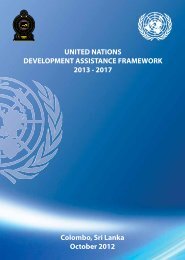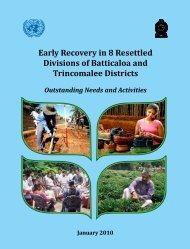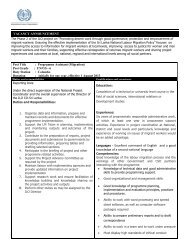Sri Lanka Human Development Report 2012.pdf
Sri Lanka Human Development Report 2012.pdf
Sri Lanka Human Development Report 2012.pdf
Create successful ePaper yourself
Turn your PDF publications into a flip-book with our unique Google optimized e-Paper software.
Box 3.2 .....Continued<br />
What has been done so far<br />
<strong>Sri</strong> <strong>Lanka</strong> has taken initiatives to stop violence<br />
against women, such as the Domestic Violence<br />
Act of 2005. It has ratified all key international<br />
mechanisms on human rights, including four major<br />
instruments relevant to rape and other forms of<br />
gender-based violence.<br />
Following the passage of the Domestic Violence<br />
Act, the Forum against Gender-Based Violence<br />
was set up. Programmes help raise awareness<br />
among women and extend assistance through both<br />
government and non-governmental organizations.<br />
One-stop crisis centers are in place in government<br />
hospitals, and there are women’s desks at police<br />
stations.<br />
1<br />
United States Agency for International <strong>Development</strong> 2009b.<br />
2<br />
World Health Organization 2005.<br />
3<br />
Department of Census and Statistics of <strong>Sri</strong> <strong>Lanka</strong> 2011e.<br />
Health Care Services<br />
Decades of health investment have enabled <strong>Sri</strong> <strong>Lanka</strong> to<br />
achieve commendable health outcomes. Today, public<br />
health care is provided free of charge at government<br />
hospitals and dispensaries to all citizens, although the<br />
supply is unable to meet the demand. While the public<br />
health sector serves nearly 60 percent of the population,<br />
out-of-pocket health expenditure is very high, as will be<br />
discussed later in this chapter. 79<br />
Responsibility for the public health service devolved<br />
from the central Government to the provincial councils<br />
with Provincial Council Act No. 42 of 1987. As a result,<br />
apart from the Health Ministry at the national level, there<br />
are nine provincial ministries of health. The Ministry of<br />
Indigenous Medicine promotes ayurvedic medicine.<br />
Compared to the public sector, the role of the private<br />
sector in health care is smaller, but has increased over time.<br />
Only 46 private hospitals operated in 1990; by 2000, their<br />
number grew to 65, and by 2008 to 90. 80 Private hospitals<br />
are largely concentrated in the Western Province, which in<br />
2008 had 60 percent of them and 75 percent of all private<br />
hospital beds. 81<br />
Health Facilities<br />
Access to health care is a complex process, encompassing<br />
service availability, the adequate supply of services and the<br />
opportunity to obtain health care. 82 The extent to which a<br />
population gains access depends on a variety of financial,<br />
organizational, social and cultural factors. 83<br />
According to the Ministry of Health, by the end of 2007,<br />
<strong>Sri</strong> <strong>Lanka</strong> had 608 hospitals and 68,694 patient beds,<br />
including maternity homes and central dispensaries, and<br />
72 government medical institutes, including teaching,<br />
provincial and base hospitals. 84 There were 62 ayurvedic<br />
hospitals and 208 central ayurvedic dispensaries, with<br />
1,424 physicians serving public ayurvedic hospitals. 85<br />
The number of government hospitals increased from 558<br />
in 2000 to 615 in 2007. On average, a free Western-type<br />
government health care service can be found within 4.8<br />
kilometres of any home. 86<br />
In 2011, 11,023 medical officers and 31,466 nurses worked<br />
in the public hospital system. The number of medical<br />
officers and nurses per 100,000 people increased from<br />
41.1 to 55.1, and 76 to 157.3, respectively, from 2000 to<br />
2007. 87<br />
This enormous health infrastructure is not equitably<br />
distributed. There are fewer government hospitals in the<br />
Northern and Eastern provinces (i.e. Jaffna, Killinochchi,<br />
Mannar, Vavuniya, Mullaitivu, Batticaloa, Ampara and<br />
Trincomalee), although the situation improved markedly<br />
from 2000 to 2007 (Figure 3.7).<br />
Chapter 3 Bridging <strong>Human</strong> <strong>Development</strong> Gaps: Health 47






